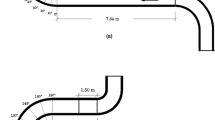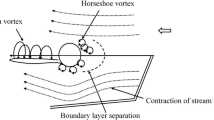Abstract
In this study, the effect of the structure geometry, the bed material, and the river hydraulic conditions on the scour morphology downstream of the stepped-baffle weirs are experimentally investigated. All experiments are conducted in clear water conditions (no sediment transport). Results show, that in the presence of stepped-baffle weirs, the maximum scour depth diminishes with respect to the simple stepped weirs (no baffle) highlighting that increasing the tailwater depth, decreases the maximum scour depth, and decreasing the structure slope, decreases the maximum scour depth. By means of dimensional analysis and incomplete self-similarity, a formula is proposed to predict the maximum scour depth downstream of a stepped-baffle weir considering all aspect ratios of the structure geometry.







Similar content being viewed by others
Abbreviations
- B :
-
Channel and stepped weir width
- b x :
-
Baffle width
- D :
-
Pier diameter
- d 50 :
-
Stilling basin median particle diameter
- D h :
-
Hydraulic depth
- D h = y 0 :
-
Upstream approach flow depth that the maximum observed y0 = yt + Δy
- d s :
-
Maximum scour depth
- f:
-
Functional symbol
- Fd :
-
Particle Froude number
- g :
-
Gravity acceleration
- G s :
-
Relative density of bed material
- h stp :
-
Height of each step
- h x :
-
Baffle height
- k :
-
Number of distances between baffles
- l stp :
-
Length of each step
- l x :
-
Baffle length
- m :
-
Number of basic dimensions
- n :
-
Number of dimensional variables of the original function and
- P :
-
Structure height
- Q :
-
Discharge.
- R = VD h/υ :
-
Reynolds number
- t :
-
Scour development time,
- t*:
-
Dimensionless time for scouring downstream of the bridge piers
- T*:
-
Dimensionless time for scouring downstream of the stepped weir
- V :
-
Upstream approach flow velocity
- w x :
-
Distance between baffles
- W x = k w x :
-
Total distance between baffles
- y t :
-
Tailwater depth
- Δy :
-
Difference between water surface elevation upstream and downstream of stepped weir
- η = Fd 2 Δy/P :
-
Scour self-similar parameter downstream
- ρ :
-
Water density
- ρ s :
-
Stilling basin bed material density
- υ :
-
Kinematic viscosity
- Ω:
-
Functional symbol
References
Bormann N E and Julien P Y 1991 Scour downstream of grade control structures. J. Hydraul. Eng. 117(5): 579–594
D’Agostino V and Ferro V 2004 Scour on alluvial bed downstream of grade control structures. J. Hydraul. Eng. 130(1): 24–37
Ben Meftah M and Mossa M 2006 Scour holes downstream of bed sills in low gradient channels. J. Hydraul. Res. 44(4): 497–509
Dey S and Raikar R V 2007 Scour below a high vertical drop. J. Hydraul. Eng. 133(5): 564–568
Bhuiyan F, Hey R D and Wormleaton P R 2007 Hydraulic evaluation of W-weir for river restoration. J. Hydraul. Eng. 133(6): 596–609
Chinnarasri C, Donjadee S and Israngkura U 2008 Hydraulic characteristics of gabion-stepped weirs. J. Hydraul. Eng. 134(8): 1147–1152
Pagliara S, Kurdistani S M and Roshni T 2011 Rooster tail wave hydraulics of chutes. J. Hydraul. Eng. 133(9): 1085–1088
Pagliara S and Kurdistani S M 2013 Scour downstream of cross-vane structures. J. Hydro-environ. Res. 7(4): 236–242
Pagliara S and Kurdistani S M 2014 Scour characteristics downstream of grade-control structures River Flow 2014. Schleiss et al (Eds). 2093–2098. Taylor & Francis Group. London
Scurlock S M, Cristopher L T and Steven R A 2012 Equilibrium scour downstream of three-dimensional grade control structures. J. Hydraul. Eng 138(2): 167–176
Kurdistani S M and Pagliara S 2015 Scour characteristics downstream of grade-control structures: Log-vane and log-deflectors comparison. World Environmental and Water Resources Congress 2015: Floods, Droughts, and Ecosystems, ASCE, Reston, VA, 1831–1840
Kurdistani S M and Pagliara S 2017 Experimental study on cross-vane scour morphology in curved horizontal channels. J. Irrig. Drain. Eng. 143(7): 1–9
Khosronejad A, Kozarek J L, Diplas P, Hill Jha R, Chatanantavet P, Heydari N and Sotiropoulos F 2018 Simulation-based optimization of in-stream structures design: rock vanes. Environ. Fluid Mech. 18(3): 695–738
Guan D, Liu J, Chiew Y M and Zhou Y 2019 Scour evolution downstream of submerged weirs in clear water scour conditions. Water (Switzerland). 11(9): 1746
Wang L, Melville B W and Guan D 2018 Effects of upstream weir slope on local scour at submerged weirs. J. Hydraul. Eng. 144(3): 04018002
Wang L, Melville B W, Guan D and Whittaker C N 2018 Local scour at downstream sloped submerged weirs. J. Hydraul. Eng. 144(8): 04018044
Wang L, Melville B W, Whittaker C N and Guan D 2019 Scour estimation downstream of submerged weirs. J. Hydraul. Eng. 145(12): 06019016
Wang L, Melville B W, Whittaker C N and Guan D 2020 Temporal evolution of clear-water scour depth at submerged weirs. J. Hydraul. Eng. 146(3): 06020001
Azimi A H, Shabanlou S, Yosefvand F, Rajabi A and Yaghoubi B 2020 Estimation of scour depth around cross-vane structures using a novel non-tuned high-accuracy machine learning approach. Sadhana Acad. Proc. Eng. Sci. 45(1): 152
Shahbazbeygi E, Yosefvand F, Yaghoubi B, Shabanlou S and Rajabi A 2021 Generalized structure of group method of data handling to prognosticate scour around various cross-vane structures. Arab. J. Geosci. 14(12): 1121
Roy D, Pagliara S and Palermo M 2021 Experimental analysis of scour features at chevrons in a straight channel. Water (Switzerland). 13(7): 971
Melville B W, Yang Y, Xiong X, Ettema R and Nowroozpour A 2021 Effects of streamwise abutment length on scour at riprap apron-protected setback abutments in compound channels. J. Hydraul. Eng. 147(3): 04021003
Chanson H 1994 Hydraulics of skimming flows over stepped channels and spillways. J. Hydraul. Res. 32(3): 445–460
Ohtsu I, Yasuda Y and Takahashi M 2004 Flow characteristics of skimming flows in stepped channels. J. Hydraul. Eng. 130(9): 860–869
Pagliara S and Palermo M 2013 Rock grade control structures and stepped gabion weirs: scour analysis and flow features. Acta Geophys. 61(1): 126–150
Pagliara S, Palermo M, Kurdistani S M and Hassanabadi L S 2015 Erosive and hydrodynamic processes analysis downstream of low-head rock made control structures. J. App. Water Eng. Res. 3(2): 122–131
Zhang G and Chanson H 2016 Gabion stepped spillway: interactions between free-surface, cavity, and seepage flows. J. Hydraul. Eng. 142(5): 06016002-1–5
Pandey M, Oliveto G, Pu J H, Sharma P K and Ojha C S P 2020 Pier scour prediction in non-uniform gravel beds. Water 12(1696): 1–21
Garg V, Setia B, Singh V and Kumar A 2021 Scour protection around bridge pier and two-piers-in-tandem arrangement. ISH Journal of Hydraulic Engineering. 1–13
Pandey M, Jamei M, Karbasi M, Ahmadianfar I and Xuefeng C 2021 Prediction of maximum scour depth near spur dikes in uniform bed sediment using stacked generalization ensemble tree-based frameworks. J. Irrig. Drain. Eng. 147(11): 1–9
Jain R, Lodhi A S, Oliveto G and Pandey M 2021 Influence of cohesion on scour at piers founded in clay–sand–gravel mixtures. J. Irrig. Drain. Eng. 147(10): 1–9
Shan J and Toth C K 2018 Topographic laser ranging and scanning: Principles and processing. CRC Press, Taylor & Francis Group, Boca Raton, FL, USA. ISBN 9781498772273
Chen J G, Zhang J M, Xu W L and Wang Y R 2010 Scale effects of air-water flows in stilling basin of multi-horizontal submerged jets. J. Hydrodyn. 22(6): 788–795
Whitehouse R J S and Chesher T J 1994 Seabed roughness in tidal flows - a review of existing measurements. Report SR360, HR Wallingford Ltd
Melville B W and Chiew Y M 1999 Time scale for local scour at bridge piers. J. Hydraul. Eng. 125(1): 59–65
Esmaeili Varaki M, Kurdistani S M and Noormohammadi G 2021 Scour morphology downstream of submerged block ramps. J. App. Water Eng. Res.. https://doi.org/10.1080/23249676.2021.1908918
Barenblatt G I 1987 Dimensional analysis. Gordon and Breach Science, New York
Kurdistani S M, Tomasicchio G R and D’AlessandroHassanabadi F L 2019 River bank protection from ship-induced waves and river flow. Water Sci. Eng. 12(2): 129–135
Kurdistani S M, Aristodemo F, Francone A, Tripepi G and Tomasicchio G R 2021 Formula for the maximum reference pressure at the interface of the breakwater core and filter layer. Coast. Eng. J. 63(4): 532–544
Tomasicchio G R, Kurdistani S M, D’Alessandro F and Hassanabadi L 2020 Simple wave breaking depth index formula for regular waves. J. Waterway Port Coastal Ocean Eng. 146(1): 06019001
Tomasicchio G R and Kurdistani S M 2020 New prediction formula for pore pressure distribution inside rubble-mound breakwater core. J. Waterway Port Coastal Ocean Eng. 146(3): 04020005
Author information
Authors and Affiliations
Corresponding author
Rights and permissions
About this article
Cite this article
Kurdistani, S.M., Varaki, M.E. & Larsari, Z.K. Scour downstream of stepped-baffle weirs in wide rivers. Sādhanā 47, 178 (2022). https://doi.org/10.1007/s12046-022-01961-9
Received:
Revised:
Accepted:
Published:
DOI: https://doi.org/10.1007/s12046-022-01961-9




